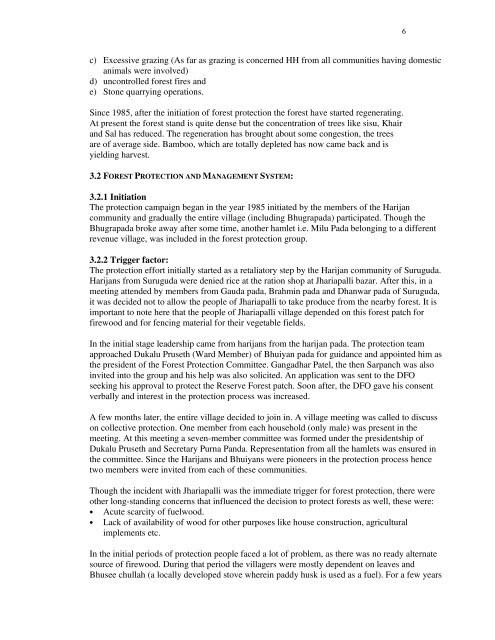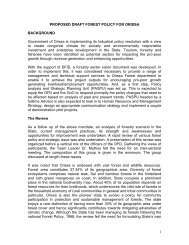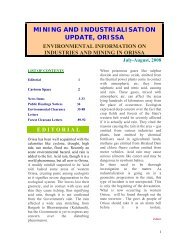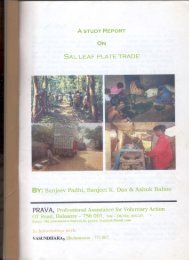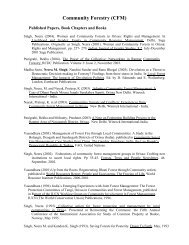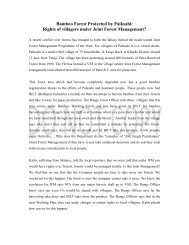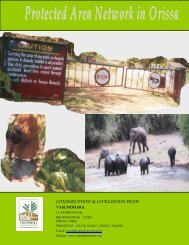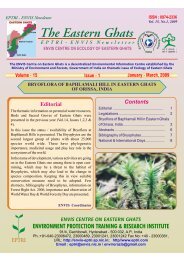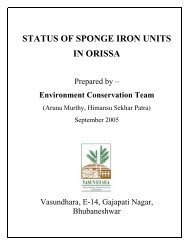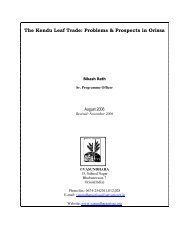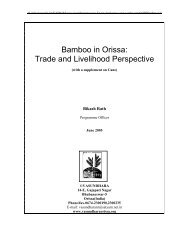DEVOLUTION OF FOREST MANAGEMENT - Vasundhara
DEVOLUTION OF FOREST MANAGEMENT - Vasundhara
DEVOLUTION OF FOREST MANAGEMENT - Vasundhara
- No tags were found...
Create successful ePaper yourself
Turn your PDF publications into a flip-book with our unique Google optimized e-Paper software.
6c) Excessive grazing (As far as grazing is concerned HH from all communities having domesticanimals were involved)d) uncontrolled forest fires ande) Stone quarrying operations.Since 1985, after the initiation of forest protection the forest have started regenerating.At present the forest stand is quite dense but the concentration of trees like sisu, Khairand Sal has reduced. The regeneration has brought about some congestion, the treesare of average side. Bamboo, which are totally depleted has now came back and isyielding harvest.3.2 <strong>FOREST</strong> PROTECTION AND <strong>MANAGEMENT</strong> SYSTEM:3.2.1 InitiationThe protection campaign began in the year 1985 initiated by the members of the Harijancommunity and gradually the entire village (including Bhugrapada) participated. Though theBhugrapada broke away after some time, another hamlet i.e. Milu Pada belonging to a differentrevenue village, was included in the forest protection group.3.2.2 Trigger factor:The protection effort initially started as a retaliatory step by the Harijan community of Suruguda.Harijans from Suruguda were denied rice at the ration shop at Jhariapalli bazar. After this, in ameeting attended by members from Gauda pada, Brahmin pada and Dhanwar pada of Suruguda,it was decided not to allow the people of Jhariapalli to take produce from the nearby forest. It isimportant to note here that the people of Jhariapalli village depended on this forest patch forfirewood and for fencing material for their vegetable fields.In the initial stage leadership came from harijans from the harijan pada. The protection teamapproached Dukalu Pruseth (Ward Member) of Bhuiyan pada for guidance and appointed him asthe president of the Forest Protection Committee. Gangadhar Patel, the then Sarpanch was alsoinvited into the group and his help was also solicited. An application was sent to the DFOseeking his approval to protect the Reserve Forest patch. Soon after, the DFO gave his consentverbally and interest in the protection process was increased.A few months later, the entire village decided to join in. A village meeting was called to discusson collective protection. One member from each household (only male) was present in themeeting. At this meeting a seven-member committee was formed under the presidentship ofDukalu Pruseth and Secretary Purna Panda. Representation from all the hamlets was ensured inthe committee. Since the Harijans and Bhuiyans were pioneers in the protection process hencetwo members were invited from each of these communities.Though the incident with Jhariapalli was the immediate trigger for forest protection, there wereother long-standing concerns that influenced the decision to protect forests as well, these were:• Acute scarcity of fuelwood.• Lack of availability of wood for other purposes like house construction, agriculturalimplements etc.In the initial periods of protection people faced a lot of problem, as there was no ready alternatesource of firewood. During that period the villagers were mostly dependent on leaves andBhusee chullah (a locally developed stove wherein paddy husk is used as a fuel). For a few years


